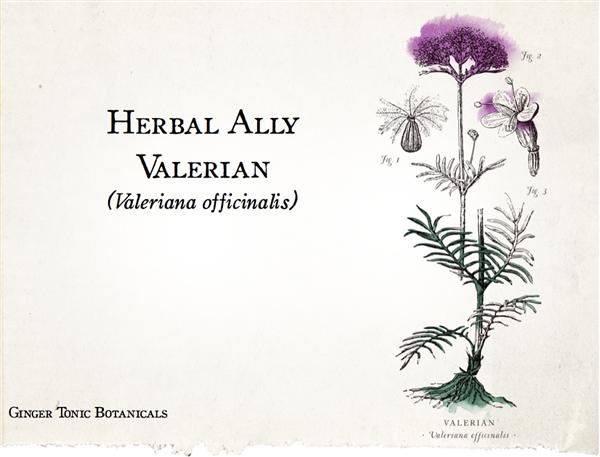
Valerian is an herb that’s close to my heart. It’s usually always the magical sounding herbal remedy tossed around in medieval stories for “sleeping draughts” that folks randomly pick along the roadsides while in transit with their gypsy caravans. It’s developed a reputation for inducing deep, dreamy slumber, and with good reason. It’s one of the oldest herbal remedies with documented medicinal use, spanning hundreds of years and countless generations. It’s a tried and true ally for me, because sleeping is probably one of my favorite things to do, and on the random night when I can’t sleep, my whole life seems unbearable.
So here’s the lowdown on Valerian (Valeriana officinalis):
Major constituents include essential oils, iridoid esters and valerenic acids (a non volatile sesquiterpene derivative).The valerenic acids are what you’ll find to be “standardized” with some supplements to enhance potency.)
Parts used include the rhizome with the rootlets. Yep – you’ll know right away it’s valerian root with that classic stinky gym sock smell. When purchasing, aim for the coarsely chopped roots/cut and sift that are a light tan colored. The roots are heat sensitive, so the lighter the color, the better they were processed and dried and not exposed to high heat.
Primary Actions: Valerian primarily influences the nervous system (AKA a nervine) and has a remarkably calming and relaxing effect. It has an affinity for GABA and adenosine receptors which will help lull you off to sleep and relax you (alternately, coffee blocks these receptors, get it?). At higher doses, it’s relaxing effect is ideal for people with sleep onset insomnia (in combination with behavior modifications) or who have a heightened sense of anxiety in the evening. However, tricky this little plant is because at low doses, it’s actually stimulating. You’ll need to take valerian for a couple of days to really see a solid effect, and you’ll know within 7 days if this is the right herb for you or not. Aim to start at about 500mg and work up from there, paying close attention to how it is affecting you at different doses.
When I’m recommending valerian, I’m either giving a tincture (hydroalcoholic extract), or mixing the chopped root in with a sleepy herbal tea combination, or sending folks away with a capsule if that’s they’re preferred method of taking it (like I said, it’s got a pretty funky taste…). For capsules, I really like Gaia, Oregon’s Wild Harvest, or Mountain Rose Herbs – all amazing quality products. There’s also some other unique and delicious way to take valerian…and those recipes you’ll be privy to with later posts 🙂
So lets paint a picture of the classic Valerian person: A generally robust, pale and sluggish person who is routinely exhausted with anxiety and stress on a daily basis. Generally they may run cold with slower circulation and difficulty making quick decisions. They may present an able-and-willing persona, but underneath they’re significantly fatigued and possibly emotionally distraught. They’re usually the people that are asked to do more than they can handle…and they’re likely to say yes, even if they know it will deplete them. They may often get a dull, persistent afternoon headache and be cold to the touch. Sometimes they may literally feel too tired to sleep, and need the gentle nudge of valerian to hold their hand into their slumber land.
Have you ever taken valerian and noticed a change? I’d love to hear from you about your experience!








